System analysis, a method of studying a system by examining its component parts and their interactions.
•It provides a framework in which judgments of the experts in different fields can be combined to determine what must be done, and what is the best way to accomplish it in light of current and future needs.
•The system analyst (usually a software engineer or programmer) examines the flow of documents, information, and material to design a system that best meets the cost, performance, and scheduling objectives.
•Systems design is the process of defining the architecture, components, modules, interfaces, and data for a system to satisfy specified requirements.
•Systems design could be seen as the application of systems theory to product development.
Successful Systems
•How will you know if you’ve helped to produce a successful system?
•Does the system achieve the goals set for it?
•How well does the system fit the structure of the business for which it was developed?
•Is the new system accurate, secure and reliable?
•Is the system well documented and easy to understand? •

•These are the main links with the environment as represented by customers and suppliers.
•It’s important to recognize, however, that the environment also interacts with the organization through legislation, social pressures, competitive forces, the education system and political decisions.
•Production system: •This is concerned with transforming raw materials into finished products. •It applies just as much in service organizations as in traditional manufacturing industry: an architectural drawing office is the equivalent of a motor engine assembly line.
•Support systems: •These are shown as the accounting, personnel and management control subsystems. •For this organization to work effectively it has to make good use of information, so the need arises for information systems that collect, store, transform and display information about the business.
Why businesses should want to develop information systems?
•To reduce manpower costs . •To improve customer service. •To improve management information. •To secure or defend competitive advantage.
Reduce manpower costs ..!
•The introduction of computer-based systems has often enabled work to be done by fewer staff or, more likely nowadays, has permitted new tasks to be undertaken without increasing staffing levels.
•Improve customer service…!
•Computer systems can often allow organizations to serve customers more quickly or to provide them with additional services.
Improve management information….!
•Management decisions can only be as good as the information on which they are based, so many computer systems have been designed to produce more, or more accurate, or more timely information. Modern database query facilities is a good example.
Secure or defend competitive advantage…..!
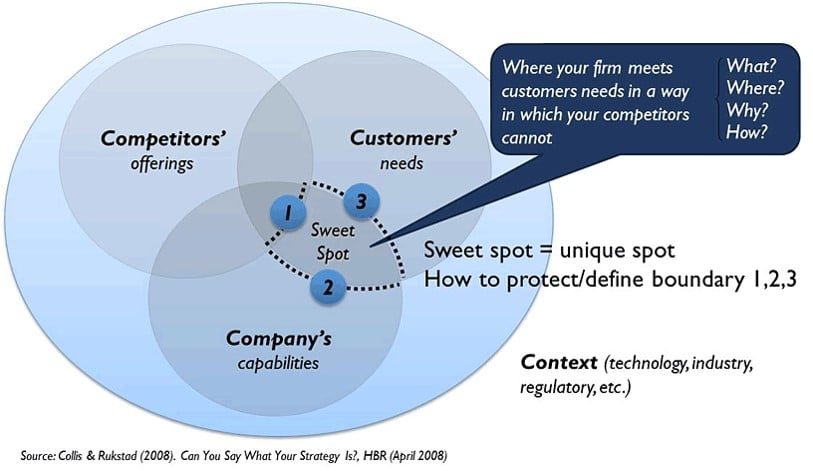
View of systems
•We can represent information systems structure in two ways: •either in a non-hierarchical way showing each subsystem on the same level, •or in an hierarchical way where some systems sit on top of others. •This multilevel view is often more helpful as it shows the different levels of control, the different data requirements, and a different view of the organization of each system.
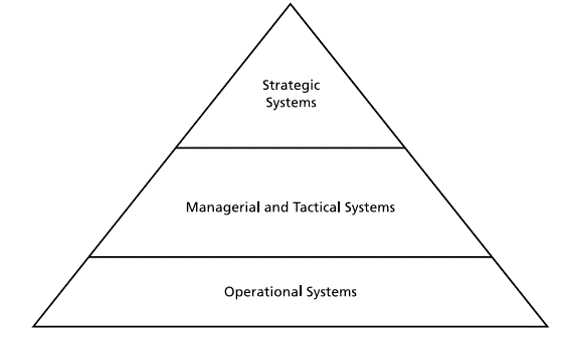
Hierarchical view of systems:
•At the top level are strategic systems and decision support systems that inform the organization.
•Strategic systems use information from lower-level internal systems and externally obtained information about markets, social trends and competitor behavior.
•Underneath strategic systems lie managerial or tactical systems that are concerned with the monitoring and control of business functions. •
•The operational systems level is concerned with the routine processing of transactions such as orders, invoices, schedules and statements.
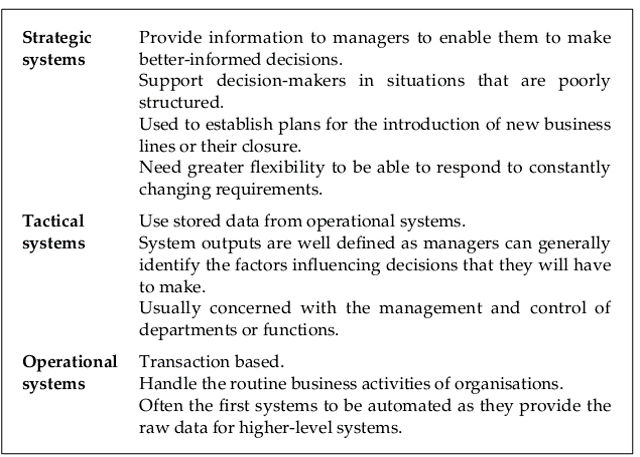
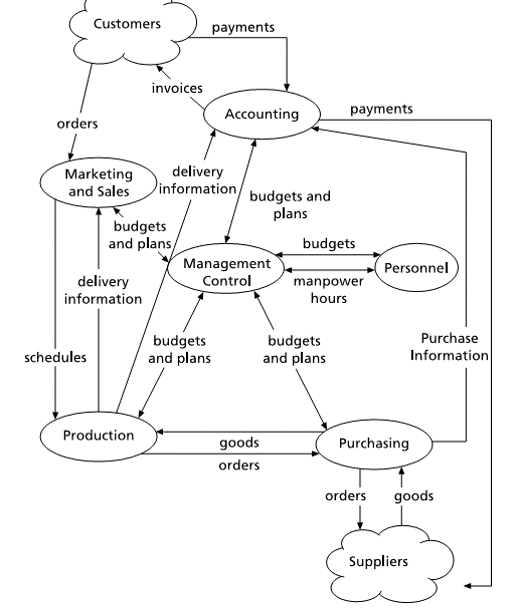
•Other models
A useful model and widely used model is the Gibson–Nolan four-stage model of: • •Initiation; •Expansion; •Formalization; •Maturity.
Gibson–Nolan four-stage model
•During the initiation phase, the repetitive processing of large volumes of transactions occurs. •Expansion stage apply the new technology to as many applications as possible. •This is the honeymoon period for the system until one day a halt is called to the ever-growing system budget and the introduction of development planning and controls signals the start of the formalization stage.
•During formalization stage the need for information surpasses the need for data and where the organization begins to plan its way from a mixture of separate data processing systems towards a more coordinated and integrated approach. •Corporate recognition of the need for integrated systems is the characteristic of the maturity stage. Here we see the use of open system architectures, database environments and comprehensive systems planning.
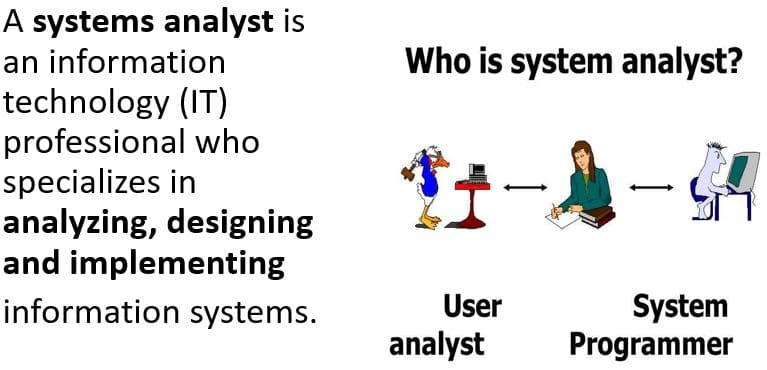
Role of the Analyst and Designer
•Analysts and designers are not always the same person
Role of the Analyst and Designer
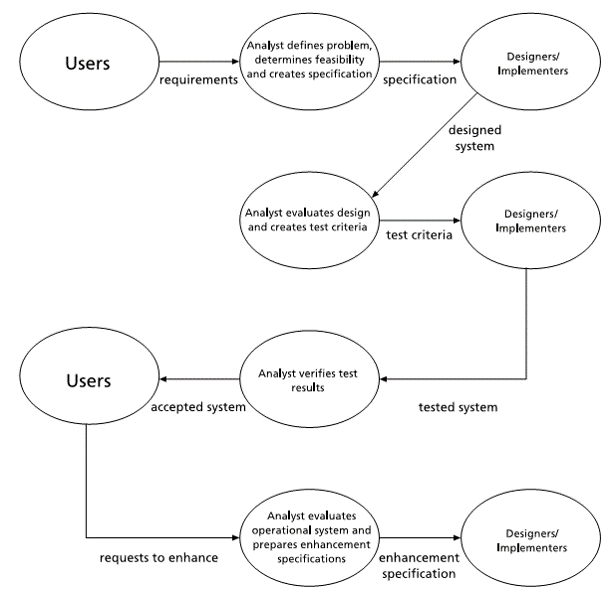
•Uncover the fundamental issues of a problem. •Able to prepare sound plans and appreciate the effect that new data will have on them, and re-plan appropriately; •To be perceptive but not jump to conclusions, to be persistent to overcome difficulties and obstacles and maintain a planned course of action to achieve results
•To exhibit stamina, strength of character and a sense of purpose essential in a professional specialist •To have a broad flexible outlook, an orderly mind and a disciplined approach, as the job will frequently require working without direct supervision •To possess higher-than-average social skills so as to work well with others, and the ability to express thoughts, ideas, suggestions and proposals clearly, both orally and in writing.
Why do we study systems analysis and design?
•Systems analysis and design, need to analyze data input or data flow systematically, process or transform data, store data, and output information in the context of a particular business. •It is used to analyze, design, and implement improvements in the support of users. •Systems analysis and design involves working with current and eventual users of information systems to support them in working with technologies in an organizational setting.
•Installing a system without proper planning leads to great user dissatisfaction and frequently causes the system to fall into disuse. •Systems analysis and design lends structure to the analysis and design of information systems, a costly endeavor that might otherwise have been done in a haphazard way.

0 Comments